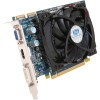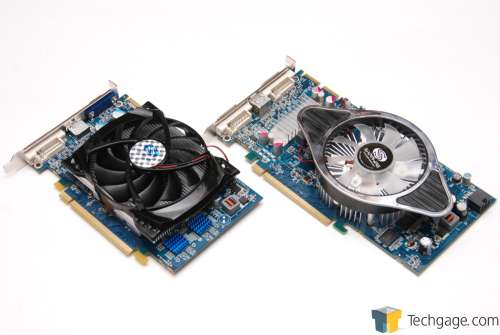- Qualcomm Launches Snapdragon 4 Gen 2 Mobile Platform
- AMD Launches Ryzen PRO 7000 Series Mobile & Desktop Platform
- Intel Launches Sleek Single-Slot Arc Pro A60 Workstation Graphics Card
- NVIDIA Announces Latest Ada Lovelace Additions: GeForce RTX 4060 Ti & RTX 4060
- Maxon Redshift With AMD Radeon GPU Rendering Support Now Available
Sapphire Radeon HD 4670 GDDR4 & HD 4830

Gaming on a budget isn’t as difficult as it once was, thanks to superb offerings from both ATI and NVIDIA that go for a modest price. But, what about the sub-$100 crowd? We’ll find that out here, at least from the ATI side of things, with Sapphire’s HD 4670 GDDR4 and HD 4830. Both feature great efficiency, and believe it or not, great overclocking as well.
Page 10 – Power, Temps & Overclocking, Final Thoughts
As I mentioned in the introduction, it’s been quite a while since we’ve taken a look at “budget” graphics cards, but I’m glad we did, because these two here are quite impressive. Aside from the nice performance, both cards have great temperature and power consumption results as well. Since we recently overhauled our testing suite (again), I don’t have enough information to create a graph for either of these, but I will tackle the specific results of these cards here.
The HD 4830 was without question the more power-hungry of the two, as it topped out at 290W during our OCCT 3.0 15 minute run, although it idled at a somewhat modest 171W. The HD 4670 on the other hand, topped out at 219W, and idled at 156W. On the temperature front, the HD 4830 idled at 35°C, and hit 72°C at the top-end, while the HD 4670 idled at 31°C and hit 62°C at load. Considering that OCCT 3.0 tends to push cards a lot harder than most games on the market, these same temperatures are unlikely to be hit in normal circumstances, unless you are running the PC in a very tight area.
The fun doesn’t stop there, though. Where overclocking is concerned, there becomes more reason to be impressed. Due to time, I didn’t test out the cards with their overclocked settings like I usually do, but I did stress-test each max stable setting to make sure they were indeed stable. For the HD 4830, which has base clocks of 575MHz/900MHz, I was extremely impressed by the fact that it could handle our overclock of 700MHz/950MHz just fine. The memory was a lot more difficult to overclock than the core, which is typical.
The HD 4670 was also quite overclockable, but due to extreme limits set by the Catalyst Control Center, the highest we could push it was 800MHz/1150, up from 750MHz/1100MHz. I need to stress that both of these cards were considered fully stable at these high clocks, so gaming on them is just fine.
Final Thoughts
Normally when I say that a graphics card is “impressive”, it’s because it delivers extremely good performance that most any gamer is going to be satisfied with. With these cards though, I’m impressed for slightly different reasons. The performance between the two wasn’t terribly impressive, but it was given the price-point of each. If I had to choose between the two of which I liked more, it would have to be the HD 4670, without question.
Although there are a few $70 models floating around from other brands, Sapphire’s card costs $10 more at a popular e-tailer for this particular model. The increase in cost is likely due in part to the inclusion of GDDR4, and also the fantastic cooler. I mentioned earlier that silence is better than having a fan, but this card was so silent, that if you didn’t know any better, you might actually assume it had a passive cooler installed.
Is the price increase worth it? That’s really something I can’t answer, since I haven’t tested other HD 4670’s, but I wouldn’t be too troubled by paying a little extra for what I believe to be the best-looking model of the bunch. The quiet cooler helps, and given that the actual passive model costs even more, the in-between price of $80 seems reasonable.
Although the HD 4670 impressed me quite a bit, the HD 4830 was also a great card. For those who don’t want to opt for the HD 4850 or higher, the HD 4830 is a fantastic card for the money, enabling better performance over the HD 4670, for those who want to increase their graphics detail in games just a pinch more. But, here’s where things get a little confusing…
As it stands right now, both of these cards are available at Newegg, and both cost the exact same ($90 – $10 MIR). That’s a little odd, and proof that we have too many GPU models on the market at any given time. For a normal PC, it makes way more sense to pick up the HD 4830, but for a SFF/HTPC, the HD 4670 is still a great choice due to its power draw, temperatures and size. It’s about 3 inches shorter than the HD 4830, so it’s definitely more appropriate for that application.
Given this information, it’s up to you to decide which one is better-suited for your tastes.
Discuss this article in our forums!
Have a comment you wish to make on this article? Recommendations? Criticism? Feel free to head over to our related thread and put your words to our virtual paper! There is no requirement to register in order to respond to these threads, but it sure doesn’t hurt!
Support our efforts! With ad revenue at an all-time low for written websites, we're relying more than ever on reader support to help us continue putting so much effort into this type of content. You can support us by becoming a Patron, or by using our Amazon shopping affiliate links listed through our articles. Thanks for your support!






